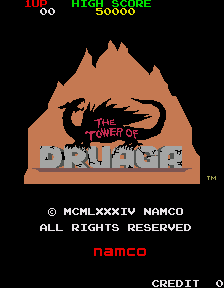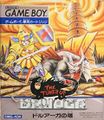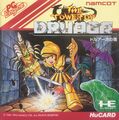- For the enhanced PC Engine remake, see The Tower of Druaga (PC Engine).
Template:Series disambig It's hard to find another game that is as embraced by Japanese players, and as panned by American players, as The Tower of Druaga. When this game was released in Japan by Namco in 1984, players flocked to it, then traded information about how to uncover its secrets. When the game was tested in American arcades, it was a complete flop. It runs on Namco Super Pac-Man hardware (two Motorola M6809 microprocessors running at 1.536 MHz), but with a video system like a one that was previously used in Mappy (modified to support horizontal scrolling).
At first glance, the game seems simple enough. It appears to be a maze game, in which a knight must navigate various corridors, fighting off monsters and searching for the key that leads to the next floor. In reality, the game is much deeper, involving hidden treasures upon every floor that require a specific unique action in order to reveal their location. Some treasures are required to beat the game, and if you miss them, or do not know how to make them appear, you will be doomed to failure no matter how hard you try. A few treasures are trapped, and can cripple your abilities and make the game more difficult than it already is. Towards the end of the game, it's even possible to be "zapped" back to a previous floor.
From some players' perspective, the amount of knowledge required to play this game correctly is beyond what they are willing to remember to make it enjoyable. But for some other players, particularly the Japanese, that is precisely what attracts them to the game so much: those little nuances that you must know, and perfect, and retain throughout all sixty floors in order to rescue the princess. As a result, the game saw no home conversions in the United States (until it was included in Namco Museum Vol. 3) but has had a plethora of releases on Japanese systems, including the Famicom, Game Boy, MSX, Sharp X68000, and a few others. An enhanced version was released for the PC Engine featuring improved isometric graphics and numerous changes. The game has spawned no less than five sequels: The Return of Ishtar (1986), The Quest of Ki (NES, 1988), The Blue Crystal Rod (SNES, 1994), and The Nightmare of Druaga (Sony PlayStation, 2004).
Story

IN ANOTHER TIME
IN ANOTHER WORLD...
THE BLUE CRYSTAL ROD
KEPT THE KINGDOM IN PEACE
BUT THE EVIL DEMON DRUAGA
HID THE ROD
AND THE MAIDEN KI
IN A TOWER
THE PRINCE GILGAMESH
WORE GOLD ARMOR
AND ATTACKED MONSTERS
TO HELP KI IN
THE TOWER OF DRUAGA
Table of Contents
Gameplay summary
- You control the knight Gilgamesh (Gil) with the four-directional joystick, and must direct him through the corridors of each of the tower's floors.
- You can press and hold the first attack button down to keep Gil's sword drawn. At that time, his shield will move from his front, to his left side.
- You must avoid contact with every enemy (except ghosts), and any of the projectiles they fire, or Gil will lose one life and must restart the floor.
- In order to complete each floor, you must find and collect a key and then walk to the door, that will open and grant you access to the next floor.
- There is one treasure hidden on every floor. Some of the contents are required in order to complete the game, while others are harmful to Gil.
- The method to reveal each treasure chest is different on every floor (but it will always be the same for each particular floor, even after you die).
Box artwork
-
Nintendo Famicom cover art.
-
Original Game Boy cover art.
-
Fujitsu FM-77 AV cover art.
-
PC-Engine remake cover art.
Cameos
Characters and much of the equipment found in the Tower of Druaga series have appeared or been referenced to in many other Namco games.
- Tales of Phantasia: much of the equipment used by Gilgamesh could be obtained.
- Tales of Destiny: contained an optional dungeon based directly off of the original Tower of Druaga (but with different treasures).
- Tales of Symphonia: the equipment used by Gilgamesh could be obtained, and the character Zelos Wilder could gain a special title by wearing it.
- Tales of the World: Narikiri Dungeon 3: also contains a variation of the dungeon. The game also contains costumes for Gilgamesh, Ki and Druaga which allows the heroes to become them in battle, and wearing the Gilgamesh costume is necessary to access the dungeon in the first place.
- Tales of Legendia: one of the "Rare Monsters" that you can find and battle is the Quox, the dragon enemies from the Druaga games.
- Tales of the Abyss: unlike the other "Tales" games, most of the cameos in the game are from Dragon Buster. However some of the rare weapons and armor in Abyss include the Golden Armor, originally worn by Gil.
- Mr. Driller: Drill Land: contains 5 worlds, one of which is called Hole of Druaga featuring a Mr. Driller game with RPG elements.
- Mr. Driller Ace: featured two levels named after Druaga characters: the "Druaga Ruins" and the "Quox Ruins".
- Namco × Capcom: several characters from the series appear in this cross over.
- Baten Kaitos: Eternal Wings and the Lost Ocean: the Tower of Druaga makes an appearance as a puzzle in Mira, complete with slimes and tools. Baten Kaitos also contains some of Gilgamesh's equipment as obtainable items.
- Soul Calibur II: one of Sophitia's alternate costumes was based on Ki's design. In addition, one of her weapon sets was the Blue Crystal Rod and Blue Line Shield, equipment formerly used by Gilgamesh and Ki. The Red Crystal Rod and Red Line Shield are also available as bonus weapons for Cassandra.
- Soul Blade: the Blue Crystal Rod mentioned above was also obtainable when Sophitia cleared the Coliseum episode in Edge Master Mode and has always been one of her weapons in the series since.
- Soul Calibur III: one of the custom souls is the soul of sword and shield, which includes the Excalibur (Hyper Sword) and Blue Line Shield as one of the available weapons for that soul.



